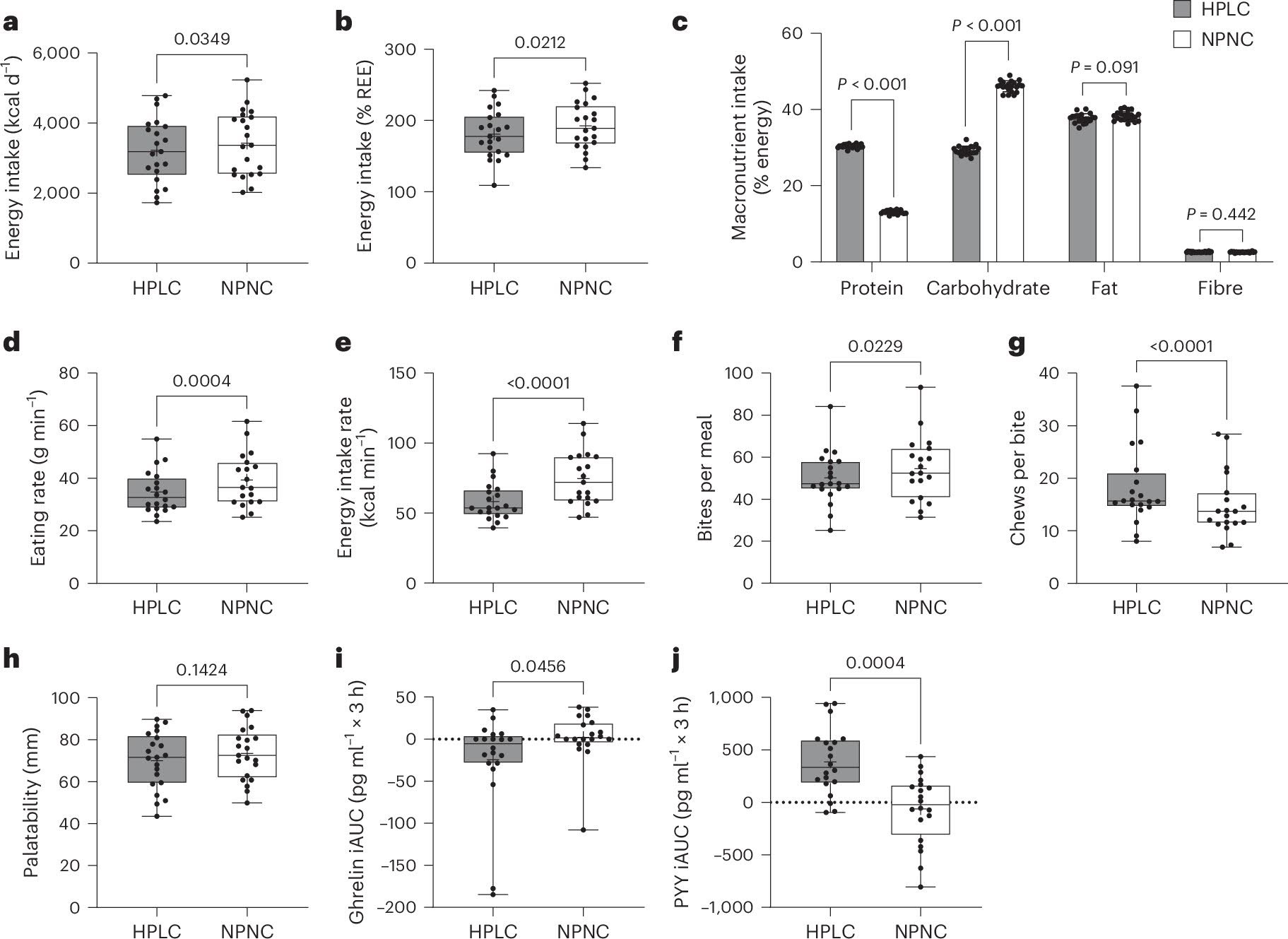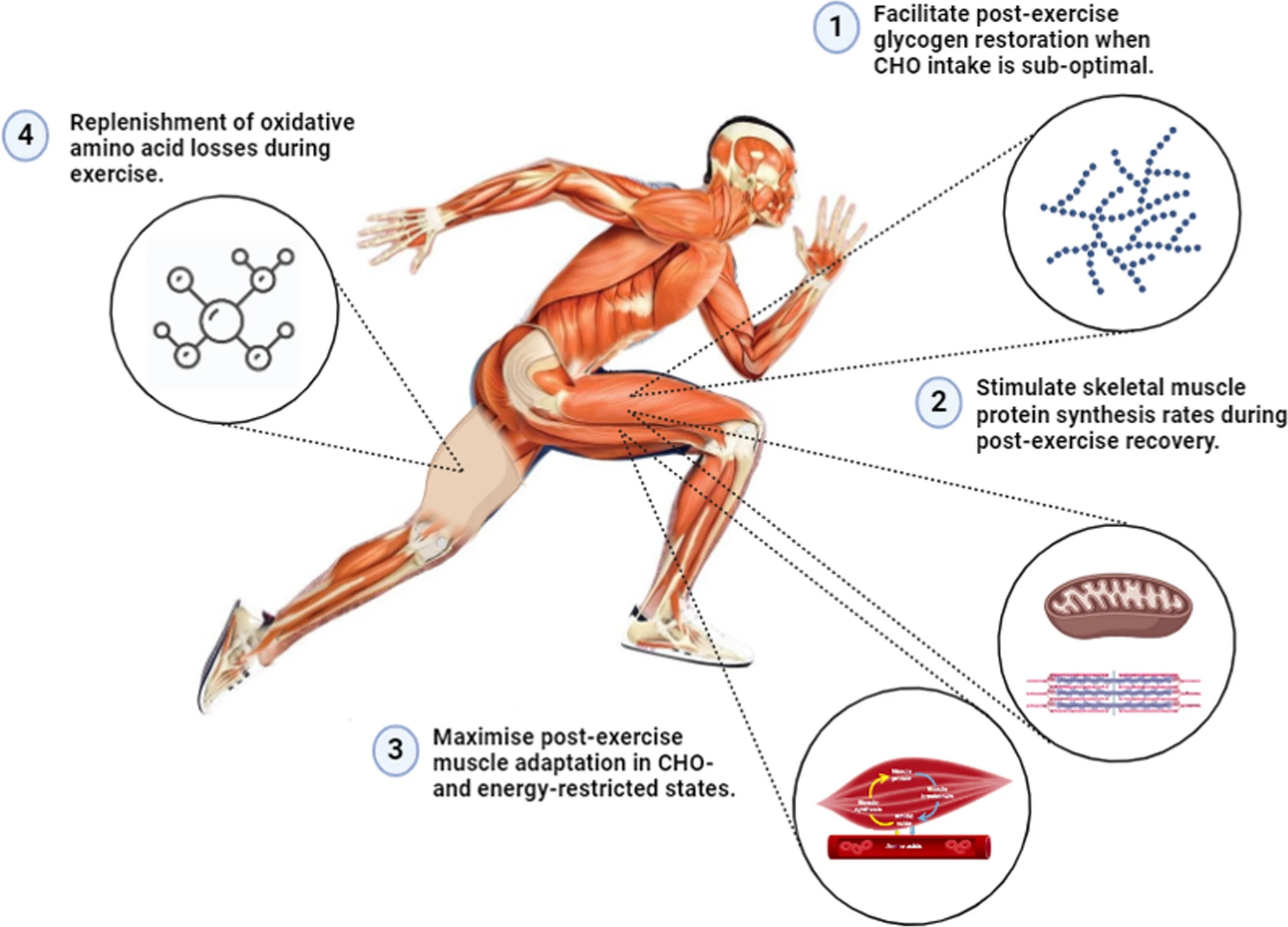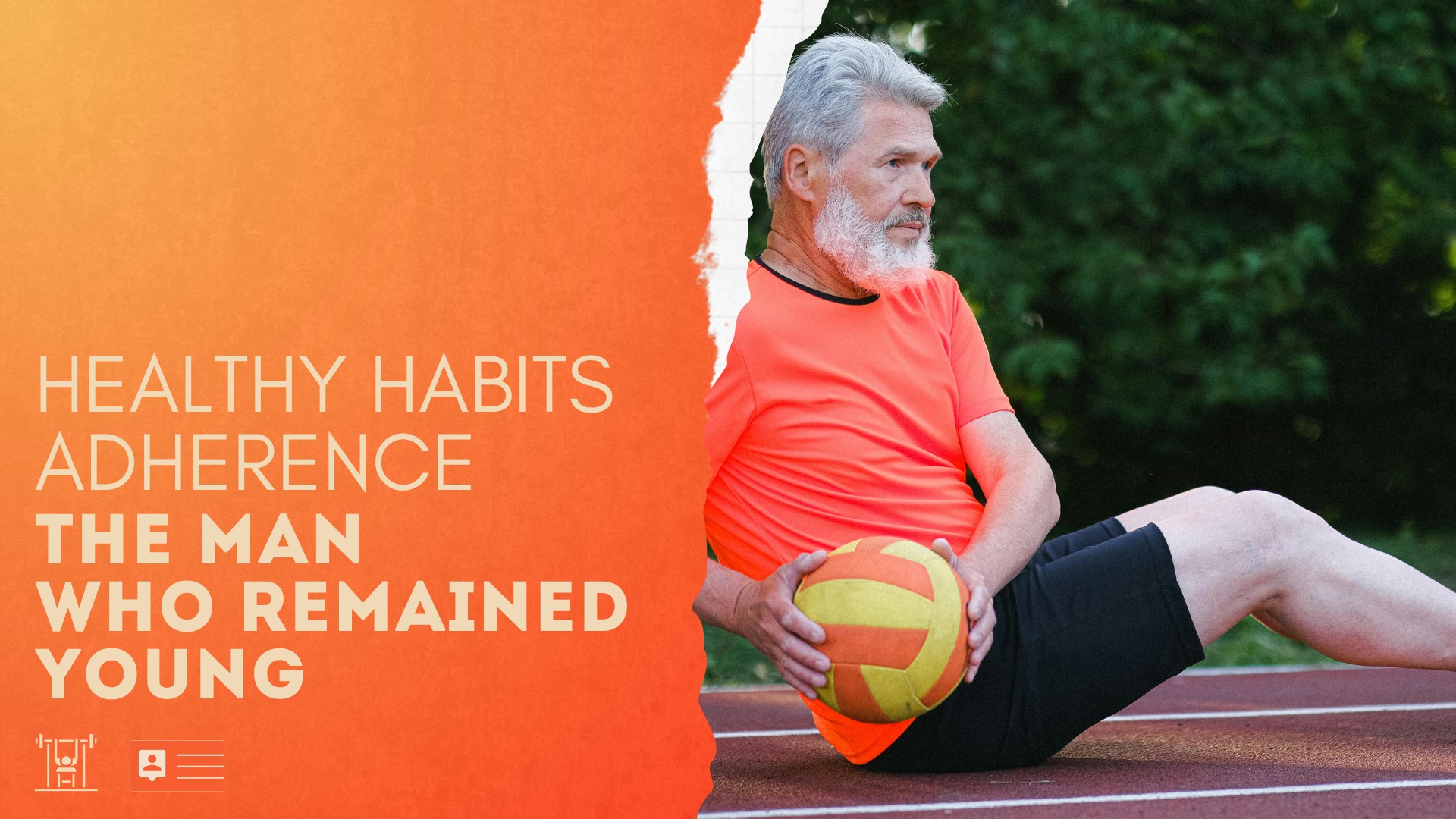Strength By Fitness
High-protein & Endurance training: Is that like cats & dogs, or the perfect symbiosis?
Welcome to another fact-based coaching article from Strength by Fitness.
The high-protein food approach that Coach Mike has been championing and coaching for the past decade
Strength By Fitness nutritionally rich high-protein, higher-SPC coaching is not just for the elderly, or the obese, and perpetually overweight that needs better habits that´s possible to adhere to long-term, so they can keep the excess body fat permanently off and enjoy better health outcomes. Neither is it just for the many strength, muscle, and power focused fitness-loving people, and athletes that regularly show up all year round in the gym no matter their age.
No, on the contrary, the nutritionally rich high-protein approach you see Strength By Fitness, and Hava talk about, and coach in our respective methods is just as beneficial for endurance loving athletes and enthusiasts too.

Hägele, F.A., Herpich, C., Koop, J. et al. Short-term effects of high-protein, lower-carbohydrate ultra-processed foods on human energy balance. Nat Metab (2025). https://doi.org/10.1038/s42255-025-01247-4
Let’s start with the measured protein Intake needs for endurance athletes that’s been confirmed in the study I will talk about today.
1.8 grams of protein per kg of body weight and day is far better for endurance athletes than a RDA protein intake, and with measurable benefits compared to 1.5g.
But, it doesn’t stop there.
2.0 g/kg/day during periods of lower carbohydrate training and rest days yet again provide measurable benefits compared to 1.8 for endurance athletes and enthusiasts.
This elevated protein requirement reflects in part the need to replenish the exercise induced loss of amino acids incurred during exercise. While also demonstrating the important energy, glycogen role of higher-SPC carbohydrates.
So when we consume less of those beneficial higher-SPC carbs a higher-protein intake allows the body to enjoy the benefits of a high-protein intake, while also using some of that protein as fuel, together with the healthy fats you also consume.
This study also displays the multi day prolonged need to supply sufficient whole proteins in order to successfully repair and adapt muscle fibers, and physical performance following high volumes of strenuous exercise training.
Once again this applies to both endurance, strength, sprint, interval and power based fitness, sports, and exercise.
In this endurance focused study protein requirement was elevated to 1.95 grams of protein per kg of body weight and day when endurance-trained men performed a similar endurance exercise bout (10-km treadmill run) coupled with a lower availability of carbohydrates.
This exceeds the often recommended 1.5 g of protein per kg and day intake for endurance athletes.
The outcome of this study is, however, not surprising at all, and very consistent with previous observations of higher amino acid oxidation rates during exercise, especially so when performed in a glycogen-depleted state. It also aligns perfectly with the many studies clearly demonstrating reduced MPS rates during a energy deficit.
A high-protein intake is a very good foundational pillar. The best, and most influential nutritional pillar we have in fact.
But, it doesn’t stop there.
What about rest days?
Recent studies indicate that the human protein requirement increases to > 2 g/kg/day when measured on a passive recovery day, i.e. 24+ hours after endurance or strength exercise.
This outcome might sound weird to the many people, and athletes who believe that they can eat a lot less food during their weekly rest days, but no, reality is that your body still needs a high amount of protein, and SPC friendly nutrients per unit of energy courtesy of the multi day price of recovery after strenuous exercise.
It takes on average 48 to 72 hours, that´s 2 to 3 days to fully recover muscle fibers after hard exercise, and during this prolonged period your body needs more nutrients per unit of energy to recover from the effort, and exhaustion you have caused, as well as to actually progress, and improve upon its current capacity.
Please note that it can take more than 3 days depending on several factors.
The difference in the actual number of days depends on exercise choice and modality, effort, load, volume and intensity. As well as muscle chain activation, nutritional intake, sleep, and rest, and your own biological age and fitness level.
Some combos of the mentioned metrics can take 7+ days to fully recover from, while others can almost recover in full in 24 hours.
During this time the nutritional requirement to consume enough protein to repair and remodel damaged proteins on a whole-body level during that prolonged multi day phase of recovery is highly elevated. To a certain degree the same thing can be said of higher SPC carbohydrate rich foods too, since getting enough quality carbs isnt just good for our health, but also aid fitness performance the following days and sessions.
Carbs are not essential, no.
But whole plant-based carbs are highly beneficial for health, and intense fitness performance, as well as a great source of fiber, and micronutrients.
But let´s get back to protein.
Because, at the end of the day, we have this simple, and massively supported, fact-based outcome.
An all year round high-protein, higher-SPC intake provides far better health outcomes and fitness progression no matter who you are, and no, it doesn’t matter if that high-protein intake is plant-based, or omnivore. You just need to consume even more protein, from more daily sources as a plant-based person to be guaranteed the same outcomes.
Do you need help maintaining better lifestyle habits?
Strength By Fitness provide private coaching, online, and on-location, in-person.
The Study.
A Metabolic Focus on Promoting Recovery and Training Adaptation
The role of dietary protein in athletic performance is well-established, particularly concerning its contribution to muscle hypertrophy. However, for endurance athletes, whose primary focus lies in cardiovascular fitness and sustained performance, protein is an equally critical macronutrient for the best possible recovery, training adaptations, maintained health, and ultimately enhanced, and injury free, endurance performance.
It is a fundamental principle in sports nutrition that individuals who engage in regular exercise training necessitate a higher intake of dietary protein compared to their sedentary fellow humans. A basic fact that does not change that every single obese, and overweight person on the planet would have a much easier time eating in a healthy, fat loss promoting way if they adopted a nutritionally rich, high-protein, higher-SPC food approach.
This increased protein & nutritional demand in general due to regular exercise arises from the physiological stresses imposed on the body during regular exercise activity. Duration, effort, and volume will also affect this increased need.
Necessitating adequate protein for muscle repair and remodeling processes in order to not just maintain, and improve performance, but to remain injury free, and healthy too.
Scientific investigations like this endurance, protein focused study into the specific protein needs of endurance athletes aim to provide evidence-based guidelines that address the total daily protein requirement to support endurance athletes’ metabolic demands.
Many endurance athletes typically consume a daily protein intake of around 1.5 grams per kilogram of body mass. While this is already really good, we can still do better.
Contemporary studies have since long established that protein requirements suggest that a daily intake of approximately 1.6 to 1.8 grams per kilogram of body mass should be advocated for the active fitness population during standard training. In part based on the simple fact that protein related outcomes, and protein synthesis itself seems to almost universally be maxed out around 1.6g per kg and day, all while older people, and plant-based people need slightly more protein to reach full amino acid levels, and equal outcomes due to differences in bioavailability, and absorption.
The general protein recommendation represents a significant increase compared to the 0.8 grams per kilogram of body mass per day that´s long been recommended for sedentary adults that wish to maintain basic functions, and health.
This new endurance athletes and protein intake study highlight the elevated protein needs associated with endurance training.
It is important to note that this requirement is not static and can be further elevated under specific conditions, as I have already mentioned in this article.
For instance, during periods of carbohydrate-restricted training, when the body might rely more on protein for energy, the daily protein requirement may exceed 2.0 grams per kilogram of body mass.
The Luteal Phase and Female Athletes.
Similarly, on rest days, protein remains crucial for muscle repair and recovery from previous training bouts, also necessitating a higher protein, higher-SPC intake. Some minor evidence suggests that female endurance athletes may experience a minutely increased protein need, particularly during the luteal phase of their menstrual cycle, where intakes up to 1.9 grams per kilogram of body mass per day might provide to be beneficial. Although, I would like to point out that this conclusion of this study is kind of highlighting something very trivial when they focus on the luteal phase for women.
After all, all female athletes should be on a 1.8+ high-protein intake every day of life already, just like male athletes.
The slight variability in these recommendations in this study underscores the multifaceted interplay of training intensity, dietary strategies, satiety, and individual physiological factors in determining optimal protein intake.
However, let this big pillar coach save you countless of time, and focus.
The real-life differences between eating 1.8, 1,9, or 2.0 gram of protein per kg of bodyweight and day are miniscule. So why would you worry about having it perfectly dialed in? In fact, the hypertrophic difference between 1.6 and 2.0 is already very small.
In other words, since protein also favor vastly better nutrients per unit of energy food habits, just make it a habit of consuming around 2.0 grams of protein/kg/day together with making every meal a higher-SPC meal.
No matter how fit you are, or overweight with excess body fat to lose.
Instead of worrying about the exact intake thats optimal just do this.
If you still have excess body fat to lose, dial your protein intake up even more, beyond 2.0.
If, on the other hand, you are losing too much body fat, and feel that exercise performance, recovery and progression is suffering, dial down the SPC factor jut a little bit, by primarily adding more plant-based whole carbs from fruit, and berries, this is easy, high quality energy loaded with micronutrients, unless you can make room for one more meal per day.
Becoming to lean is also detrimental.
Excess body fat has no health benefits, and neither does it help any athletes outside of maybe heavy weight powerlifters. But, having too little body fat actively harms fitness performance, and health, so if you are becoming too lean, add one meal, and or lower the SPC by consuming more easy energy foods loaded with health promoting micronutrients, such as fruit, and berries. Heck in this situation, even low SPC foods such as dried dates can be a great choice.
Beyond the total daily intake, the timing and distribution of protein consumption throughout the day have been a topic of discussion. While earlier research suggested aiming for a per-meal protein intake of approximately 0.5 grams per kilogram of body mass to maximally stimulate the synthesis of contractile muscle proteins, recent evidence indicates that the human body can absorb and utilize a larger amount of protein per meal.
Studies suggest that muscle protein synthesis (MPS) can be maximized with intakes ranging from 40+ grams of high-quality protein per meal, depending on factors like body size and activity level.
Current research even highlight that the anabolic responses related to protein might continue to increase with protein ingestion close to 100 grams of protein per meal.
While spreading protein intake evenly throughout the day to maintain a consistent stimulus for MPS remains a valid approach, it is the total daily protein intake that is the primary driver of muscle adaptation, health outcomes, fat loss, and total food consumption.
Athletes can effectively meet their protein needs by distributing their intake across 3-4 meals, or potentially eating fewer larger meals, particularly when a significant portion of the daily protein is consumed around workout sessions.
Consuming protein before, during, and within three hours after your exercise session is highly beneficial for recovery and muscle protein synthesis. No, you do not have to do all three.
I prefer eating a high-protein meal 2 hours before my workouts, and another high-protein meal within 3 hours of my workout, in both cases, both meals are also rich in whole plant-based carbs, and micronutrients.
Protein Type, and quality, all proteins are not the same, but you can also just eat much more of the lower quality proteins.
The type of protein consumed can also influence recovery and training adaptation. Especially so for people on a lower protein intake.
Plenty of studies have highlighted the benefits of ingesting high-quality proteins, such as whey, soy, pea isolate, and Quorn within 3 hours after exercise, and or 2 hours prior to exercise.
As these higher protein sources can significantly improve muscle recovery and promote hypertrophy.
Protein quality is determined by its ability to provide adequate quantities of the essential amino acids that´s required for protein synthesis, maintained, and improved health and fitness performance.
Leucine, a branched-chain amino acid, has been identified as a key stimulator of skeletal muscle protein synthesis, making protein sources rich in leucine particularly valuable for endurance athletes.
Multiple daily whole high-quality protein sources should be the primary focus, but protein supplements can offer additional convenience and benefits for exercise performance, fat loss, health, satiety and recovery.
At Strength By Fitness it is our longstanding recommendation to maintain a food plan that makes of 3 to 4 main protein sources per day. This ensures a wider micronutrient intake, and better amino acid levels. Especially important for the elderly, and the plant-based, but also beneficial for most omnivores, since billions of omnivores are nutritionally deficient.
The benefits of adequate protein intake for people in general, and endurance athletes extend beyond just muscle protein synthesis.
Research suggests that protein play a supportive role in muscle glycogen resynthesis, particularly when carbohydrate intake is suboptimal.
While carbohydrates remain the primary fuel source for glycogen replenishment, the addition of protein will aid in this process when sufficient carbohydrate intake (1.2 g/kg BM/hour for competitive endurance athletes ) is challenging to achieve during the race, as well as post workout/race.
However, when carbohydrate recommendations are met, adding protein does not appear to provide additional benefits for glycogen restoration. Because you are already consuming enough carbs to saturate your glycogen stores.
Adequate protein intake is crucial for attenuating post-exercise muscle protein breakdown, especially in catabolic states such as an energy deficit.
This is particularly important for endurance and strength training athletes who often engage in prolonged and intense training sessions that leads to muscle damage, and physical exhaustion.
Protein also plays a role in optimizing the metabolic response, and health, relative to not just endurance training, but all forms of exercise especially under conditions of low carbohydrate and/or energy availability.
The current body of research strongly supports the notion that endurance athletes require a higher daily protein intake than sedentary individuals, with a recommendation of approximately 1.8 grams per kilogram of body mass on standard training days, as your minimum high-protein intake.
Per meal intake, again.
While earlier recommendations emphasized distributing protein intake evenly throughout the day with a per-meal target of around 0.5 grams per kilogram of body mass, current understanding suggests that total daily intake is more critical, and athletes can effectively meet their needs with varied meal frequencies and potentially larger protein doses per meal, particularly around workout times. Prioritizing high-quality protein sources rich in essential amino acids remains crucial for maximizing muscle protein synthesis, recovery, and training adaptation. While protein can assist in glycogen resynthesis under specific conditions, it is not a substitute for adequate carbohydrate intake when the primary goal is glycogen restoration. For endurance athletes aiming to maintain a healthier and fitter lifestyle through exercise and good food habits, prioritizing a big enough protein intake is a cornerstone of optimal nutritional support for their training, longterm health, and recovery needs.
|
Training Status/Condition |
Recommended Protein Intake (g/kg BM/day) |
Notes |
|
Standard Training |
~ 1.6 to 1.8+ |
General minimum, high-protein recommendation for daily intake. |
|
Carbohydrate-Restricted Training |
>2.0 |
Increased need due to increased reliance on protein for energy. |
|
Rest Days |
>1.8 |
Important for muscle repair and recovery. |
|
Female Athletes (Luteal Phase) |
Up to 1.9 |
May be elevated due to hormonal influences. |
|
Elite Athletes (High Intensity/Duration) |
>1.8 |
Many consume around 1.6, but there is no need to consume less than 1.8. And you can safely go even higher, until you bump into issues with getting enough energy, and needed micronutrients. |

Older people need more protein per meal and day. and they need regular strength & cardiovascular
training too

About the image.
The role of protein nutrition for optimizing endurance performance is no different than what happens when we lift weights. It promotes better exercise related adaptations and enhance post-exercise recovery.
Dietary protein intake is an important factor in facilitating muscle glycogen resynthesis under conditions of suboptimal carbohydrate (CHO) intake, and stimulating better muscle protein synthesis rates during recovery. It attenuates post-exercise protein breakdown in catabolic states such as energy restriction and replenish oxidative amino acid losses during exercise.
a High-protein intake & better fitness progression, health outcomes, and exercise recovery is a universal outcome
A higher protein intake provides more of the needed amino acids that are responsible for the repair and adaptation of skeletal muscle proteins, connective tissue, and even our organs.
Muscle protein synthesis and muscle protein breakdown are both stimulated during and after both endurance and resistance training. This process powers the resulting outcome of skeletal muscle adaptation to all fitness modalities which you do on a regular basis, even more so when you provide sufficient stimulus, nutrition ( getting enough protein & energy are major food pillars ), and recovery over time.
In addition to the multi-faceted progression of type 1, and 2 muscle fibers, new mitochondrial proteins that power energetics also adapt, and progress in response to the same physical activity, and exercise, with a clear impact for both strength & endurance performance.
Wrapping things up for this article
Everything that needed to be said has already been covered. So lets wrap this up with our Strength By Fitness higher-SPC, high-protein big pillar approach.

Maintain a high-protein, higher-SPC food intake.
Worry less about 1.6 or 1.9 grams being the optimal for you. Aim for a steady, rough 2.0g of protein per kg of bodyweight, and day, all-year-round.
![Protein requirements of endurance athletes and team sport athletes estimated using the indicator amino acid oxidation (IAAO) technique across a variety of applied settings. A IAAO estimate of protein requirement based on 13CO2 excretion in endurance-trained male individuals (n = 6) immediately following a 20-km treadmill run [47]. B IAAO estimate of protein requirement based on 13CO2 excretion in endurance-trained male individuals (n = 6) 24 h after completing a 60- to 90-min run or bike ride [49]. C IAAO estimate of protein requirement based on phenylalanine oxidation rates in endurance-trained male runners (n = 8) following a 10-km treadmill run completed in a carbohydrate-restricted or carbohydrate-fed state [50]. D IAAO estimate of protein requirement based on phenylalanine oxidation rates in endurance-trained female individuals (n = 7) during the mid-luteal phase of their menstrual cycle following a 20-km self-paced outside run [65]. E IAAO estimate of protein requirement based on 13CO2 excretion in male team-sport athletes (n = 7) immediately following a 75-min bout of intermittent exercise [9]. F IAAO estimate of protein requirement based on 13CO2 excretion in female team-sport athletes during the luteal phase of the menstrual cycle (n = 6) immediately following a 75-min bout of intermittent exercise [10]. G IAAO estimate of protein requirement based on 13CO2 excretion in untrained male individuals (n = 8) at rest [39]. BM body mass, CI confidence interval, EAR estimated average requirement, IAAO indicator amino acid oxidation, RDA recommended daily allowance; value inside each bar refers to an habitual protein intake (g·kgBM−1·day−1) of the corresponding category of athlete based on Gillen et al. data [35]; estimated %TEI percentage of total energy intake derived from protein; dashed line denotes current protein RDA (0.8 g·kgBM−1·day−1); dotted line denotes current protein EAR (0.62 g·kgBM−1·day−1) Protein requirements of endurance athletes and team sport athletes estimated using the indicator amino acid oxidation (IAAO) technique across a variety of applied settings. A IAAO estimate of protein requirement based on 13CO2 excretion in endurance-trained male individuals (n = 6) immediately following a 20-km treadmill run [47]. B IAAO estimate of protein requirement based on 13CO2 excretion in endurance-trained male individuals (n = 6) 24 h after completing a 60- to 90-min run or bike ride [49]. C IAAO estimate of protein requirement based on phenylalanine oxidation rates in endurance-trained male runners (n = 8) following a 10-km treadmill run completed in a carbohydrate-restricted or carbohydrate-fed state [50]. D IAAO estimate of protein requirement based on phenylalanine oxidation rates in endurance-trained female individuals (n = 7) during the mid-luteal phase of their menstrual cycle following a 20-km self-paced outside run [65]. E IAAO estimate of protein requirement based on 13CO2 excretion in male team-sport athletes (n = 7) immediately following a 75-min bout of intermittent exercise [9]. F IAAO estimate of protein requirement based on 13CO2 excretion in female team-sport athletes during the luteal phase of the menstrual cycle (n = 6) immediately following a 75-min bout of intermittent exercise [10]. G IAAO estimate of protein requirement based on 13CO2 excretion in untrained male individuals (n = 8) at rest [39]. BM body mass, CI confidence interval, EAR estimated average requirement, IAAO indicator amino acid oxidation, RDA recommended daily allowance; value inside each bar refers to an habitual protein intake (g·kgBM−1·day−1) of the corresponding category of athlete based on Gillen et al. data [35]; estimated %TEI percentage of total energy intake derived from protein; dashed line denotes current protein RDA (0.8 g·kgBM−1·day−1); dotted line denotes current protein EAR (0.62 g·kgBM−1·day−1)](https://strengthbyfitness.com/wp-content/uploads/2025/04/protein-and-endurance.png)
Cited study.
1. The 2005 high-protein study.
https://pubmed.ncbi.nlm.nih.gov/16002798/
2. Human evolution, energy expenditure.
https://www.pnas.org/doi/10.1073/pnas.2409674121
3. Genetics matter but habits own the driver’s seat.
https://www.sciencedirect.com/science/article/abs/pii/S0167494323002601?s=09
4. Protein for Endurance Athletes.
5. Trends in nutrition and health between 1900 and now.
https://www.sciencedirect.com/science/article/pii/S2213434423000221?via%3Dihub
6. Chronic Kidney Disease and High-protein. Improvements in health and mortality outcomes.
Kidney Disease, & High-protein Intake What´s The Health And Mortality Outcome. — Strength By Fitness
7. Low SPC, UPF and high-protein.
https://www.nature.com/articles/s42255-025-01247-4
You can also read this article over at Medium if you are a paying Medium Member.
Do you need coaching help in order to create a healthier life? Strength By Fitness coaches people online and in person. This includes fitness, fat loss, nutrition, and health. Strength training, endurance, yoga, and combat sports classes. Just click coaching in the menu up above and let us transform your health & fitness journey through life together.
strength by fitness
podcasts
recent articles

Type II Diabetes: How Fitness and Nutrition Can Mitigate and reverse t2d. Exclusive Member Article.
IF you want to prevent type 2 diabetes, or reverse it, if the damage has already been done, as it has for hundreds of millions of people around the world, you have three massively powerful and influential habits at your disposal. Welcome to another fact-based member-exclusive Strength By Fitness article.

Members & Clients Recipe: Tofu, dates & orange smoothie. High SPC & Protein.
Our Tofu, dates & orange smoothie provides 56g of Protein, 22g of fiber, and a very high SPC between 66 & 80. That makes this another tasty Strength By Fitness winner. Paid Reader & Client Exclusive Recipe.

Quality Sleep Is Just Another Habit.
Quality sleep comes from a few key pillars in a healthy lifestyle.
Yes, quality sleep is just another habit we build over time with nothing more than our own choices. In this article, Coach Mike from Strength By Fitness will teach you how to do it too.

The Man Who Remained Young. Healthy Habits vs Ageing: Exclusive Member Article.
Strength training, injury-free, 80-year-old men can be as strong as a 35-year-old gym goer. And running is no different. All it takes are maintained habits. Exclusive Strength By Fitness Member Article. Join today, only 9$ Per Year.

Genetics vs Fitness Habits: Part IV. Exclusive Member Article.
Good habits will always move everyone in the right direction. Your genes then decide just how far your ceiling goes. For every single person on the planet, this means becoming way healthier and fitter over time, and as long as you maintain those habits, the positive outcome won’t go away.

Regular Exercise Habits For Children Provide Massive Benefits All Through Life
Fitter kids rapidly become healthier kids.
These fitter and healthier kids eventually go on to become much fitter and healthier adults with a higher quality of life, better physical capacity, work performance, cognitive health, and ageing trajectories.
If they mainta…
We appreciate you
so stay healthy & never stop training
Contact
Private In-App Messaging is Available For All App + Coaching Clients
Adress
Coaching Is Available Online Via App on IOS & Google Play, and In-person, On-location.
Copyright 2025 Strength By Fitness.
